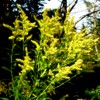
The leaves, flowers and roots of many herbs may impart dye colors such as red, blue, green, yellow, brown and gray. The herbs can be either fresh or dried however the or dried however the fresher the herb... the brighter the color. The amount of dye an herb may produce varies depending upon environmental conditions. Herbs in San Jose, California would produce different colors than those in New Paltz, New York, for example.
Then, there is making the dye itself. You have to harvest the herbs which means gathering the flowers when they are in full bloom; berries are to be picked when they are ripe. Roots and bark are better picked during the fall and leaves should be picked in the spring. Unless there are stores selling herbs already harvested, this is how one obtains herbs for dyeing. Exactly how much of the herbs you need to dye is optional. However, the general rule of thumb is to collect one peck (approx. 8 quarts) of plant material to dye one pound of wool (or whatever material you are dying). With nut hulls, wood, bark or berries use one pound per pound of cloth and with roots 1/2 pound. For each pound of material, use 4 to 4-1/2 gallons of soft water to prepare the dye bath.
Next you have to chop the leaves, roots, flowers, etc. of your choice for the color you want. Then you soak the herbs: leaves, roots, nut hulls and bark should be soaked overnight in 2 gallons of water. Then they must be strained and the first liquid saved. Next, take the remaining plant material and soak it again in 2 gallons of water, bring it to a boil and simmer for one hour. Strain out the plant material and combine with the first strained liquid.
You don't need to soak flowers, fruits and tender leaves. Place them in 4 to 4-1/2 gallons of water, bring to a boil and then simmer for 30 minutes to one hour or until the material has given up its color. Strain out the herbs. The dyeing process itself is done by soaking the material for about an hour in lukewarm water first, then placing it in the dye bath which should also be lukewarm. Then, raise the temperature until it is simmering. Dyes made from flowers may take about a half hour while dyes from bark or roots may take up to two hours. Check the process every so often by pulling the material out of the dye and looking at the color. After you are finished keep the dye bath... don't throw it out because you will never be able to duplicate it. You can keep it for use at another time.
"A Dyer's Garden; From Plant to Pot: Growing Dyes for Natural Fibers"
by Rita Buchanan
Reference: "Rodale's Illustrated Encyclopedia of Herbs."

























